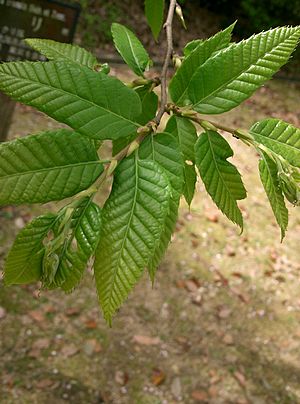Japanese chestnut facts for kids
Quick facts for kids Japanese chestnut |
|
|---|---|
 |
|
| Conservation status | |
| Scientific classification |
The Japanese chestnut (also called the Korean chestnut) is a type of chestnut tree. Its scientific name is Castanea crenata. This tree grows naturally in Japan and Korea.
It is special because it can fight off a plant disease called Phytophthora cinnamomi. This disease causes "ink disease" in other chestnut trees. The Japanese chestnut has a special gene that helps it resist this disease.
Contents
About the Japanese Chestnut Tree
The Japanese chestnut is a small to medium-sized deciduous tree. This means it loses its leaves every autumn. It can grow to be about 10 to 15 meters (33 to 49 feet) tall.
Leaves and Flowers
The leaves of the Japanese chestnut look a lot like those of the sweet chestnut. However, they are usually a bit smaller. They are about 8 to 19 centimeters (3 to 7.5 inches) long and 3 to 5 centimeters (1 to 2 inches) wide.
The tree produces long, upright flower clusters called catkins. These catkins can be 7 to 20 centimeters (3 to 8 inches) long. Both male and female flowers grow on the same catkin. The male flowers are found at the top, and the female flowers are at the bottom.
Nut Production
The flowers appear in the summer. By autumn, the female flowers turn into spiny coverings called cupules. Inside each cupule, there are usually 3 to 7 brownish nuts. These nuts fall from the tree around October.
Growing and Using Japanese Chestnuts
The Japanese chestnut is a very important tree in Japan and Korea. It produces many sweet, tasty nuts that people love to eat. Farmers have chosen special types of these trees, called cultivars, that grow very large nuts. This tree is also widely grown in eastern China and Taiwan.
Disease Resistance
This tree is strong against two serious plant diseases: chestnut blight and ink disease. This resistance makes it very important in North America. Scientists there are working to create new, disease-resistant hybrid chestnut trees. They are also using genetic engineering to help the American chestnut. The American chestnut is very easily affected by these two fungal diseases.
Hybrid Chestnuts
Some examples of hybrid chestnut trees, which are a mix of European and Japanese chestnuts, include:
- 'Colossal'
- ‘Bouche de Betizac’
- ‘Precoce Migoule’
- ‘Labor Day’
Gallery
See also
 In Spanish: Castaño japonés para niños
In Spanish: Castaño japonés para niños










